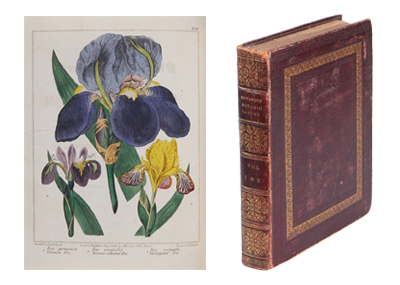
NEW YORK – Botany and medicine have been entwined since time immemorial. Because accurate descriptions of medicinal plants were essential for treatment, healers in ancient Egypt, India, China and Europe, for example, compiled handwritten herbals, collections of accumulated medical wisdom, along with plant names, descriptions and uses.
The first known illustrated volume of medicinal plants, compiled by Greek physician Crateuas, appeared in the first century B.C. Yet only De Materia Medica, complied two centuries later by Dioscorides, survived. Its hand-copied, illustrated manuscripts, likely encompassing earlier knowledge, remained the authoritative go-to for healers for well over a millennium. Several copies, including Vienna Dioscorides, a sixth century Greek illuminated version, still exist.
Many early 15th century herbals, largely based on Dioscorides’ work, featured hand-drawn illustrations or texts with images on single woodblocks. Since woodblocks deteriorate with use, copies eventually depicted plants inaccurately. Moreover, popular mythological elements also appeared. With the invention of movable type, separately etched woodblock images and texts were printed simultaneously. Yet most illustrators continued imitating historical models. According to the American Society of Botanical Artists, Leonardo da Vinci (1452-1519) and Albrecht Dürer (1471-1528), by combining scientific accuracy with beauty, created the first modern botanical illustrations.

As European seafarers mapped far-flung lands, they brought back not only marvelous tales, but botanical marvels. When cultivating exotic plants became fashionable locally, wealthy elites often commissioned botanical images to immortalize the greenery gracing their estates.
Botanist Basilius Besler (1561-1629), for instance, under the patronage of Bishop of Eichstatt, Germany, produced Hortus Eystettensis, a massive, copper engraved-plate volume depicting his remarkable garden, one of the most extensive in Europe. His splendid, near life-size sunflower, tulip and rose prints, especially those featuring early hand-coloring, are particularly collectible.

Decades later, artist Georg Dionysius Ehret (1708-1770) created sensuous hyacinth and tulip watercolors for the Margrave of Baden-Durlach, then illustrated numerous newly arrived plants at London’s Royal Botanical Gardens at Kew. Franz Bauer (1758-1840), another Botanical Garden employee, created highly detailed plant illustrations through dissection and use of a microscopic. His later prints feature ground-breaking, class/order/genus/species, Linnaean scientific classifications. Bauer’s contemporary, Pierre-Joseph Redouté (1759-1840), probably the best-known illustrator of all, also produced scores of exquisite, scientifically classified watercolors, notably roses and lilies.

Although overseas exploration continued, not all native plants could survive lengthy journeys home. So intrepid artists, including Sydney Parkinson (c. 1775-1771) aboard Capt. James Cook’s HMS Endeavor, sketched on-the-spot images. Their depictions not only acquainted the public with exotic specimens, but also generated extensive interest in science and the natural world.
Botanical prints, appearing in catalogs, guides and general journals, delighted nature lovers, amateur botanists and gardeners alike. Curtis’s Botanical Magazine (which has appeared continually since 1787), for example, offered splendid, detailed images by James Sowerby, John Nugent Fitch and Sydenham Edwards. Similar publications, like The Botanical Register and The Floral Cabinet, followed.

From the mid-1800s on, botanical illustrators like Belgian Jean Linden (1817-1898), famed for orchids, and American Daniel C. Eaton (1834-1895), famed for ferns, created even more accurate prints through chromolithography. This innovative process entailed printing images from a series of colored lithographic plates.
Despite their fragility, scores of these 18th and 19th century botanical illustrations have survived. Some, like Redouté’s original Marsh Rose (purchased by royalty for royalty, then purchased from royalty and willed to descendants before reaching auction over a century later) are in excellent condition. So are numerous first editions, copies and copies-of-copies. Those foxed, faded, stained or speckled through poor storage conditions, proximity of word to image or exposure to light, heat or humidity, are often—but not always—less desirable.

“Serious collectors interested in science, historical background, as well as beauty,” said David Goldthorpe, head of books and manuscripts at Sotheby’s, “generally seek complete bound vintage volumes.” Architects, designers, interior decorators and enthusiasts, charmed by particularly attractive flowers, he observed, tend to purchase less costly loose prints for decorative use.
After all, the image of a white lily, a yellow amaryllis or a purple rhododendron can light up an entire room.



